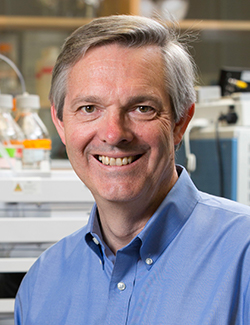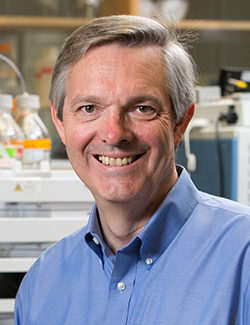Robert Haltiwanger


Short Biography:
Dr. Haltiwanger received his B.S. in Biology (1980) and Ph.D. in Biochemistry (1986) from Duke University. He went on to do postdoctoral work at Johns Hopkins University School of Medicine, and took his first independent position as an Assistant Professor in the Department of Biochemistry and Cell Biology at Stony Brook University (1991). He rose through the ranks to full Professor and served as Chair of that Department for 8 years. He moved to the CCRC in 2015 as the GRA Eminent Scholar in Biomedical Glycosciences. He has served as President of the Society for Glycobiology, Chair of the Glycobiology Gordon Conference, and currently serves as Editor-in-Chief of the journal Glycobiology.
Research Interests:
Glycobiology is a relatively young field that focuses on examining the biological effects of modifying proteins and lipids with carbohydrates. Glycans provide incredible structural diversity to biological systems, offering the potential to alter function in a wide variety of ways, but also bringing significant technical challenges for structural analysis. Advances in methodologies to examine these structures has brought significant insight into functions for glycans in a wide variety of biological contexts over the past decade, causing rapid growth and interest in the field. My laboratory focuses on the role of carbohydrate modifications on proteins, especially as they affect cellular communication events. Protein glycosylation exists in two major forms: N-linked, referring to glycans linked to protein through the amide nitrogen of asparagine residues, and O-linked, where the glycans are linked through the hydroxyl groups of serine or threonine. O-Glycans are divided into subclasses based on the carbohydrate linked directly to the serine or threonine. The subclasses that we focus on are called O-fucose and O-glucose. All of the projects in the laboratory deal with learning more about these forms of glycosylation. Several are discussed in more detail below.
Regulation of Notch Signaling by O-fucose and O-glucose:
The Notch protein plays a key role in communication between cells. It functions at the surface of the cell where it binds to ligands expressed on adjacent cells (e.g. Delta, Serrate, Jagged), resulting in its activation. Such communication between cells is essential for proper development of metazoans, and defects in Notch function result in a number of human diseases, including severe mental and physical retardation, congenital heart defects, vascular defects leading to stroke and dementia, and several forms of cancer. A clear understanding of how Notch functions is essential to develop therapies for these diseases.
We have demonstrated that O-fucose and O-glucose glycans modify the Epidermal Growth Factor-like (EGF) repeats of the Notch extracellular domain. We have identified the enzymes responsible for addition of the O-fucose, protein O-fucosyltransferase 1 (POFUT1) and O-glucose, protein O-glucosyltransferase 1 (POGLUT1) to Notch. Elimation of either of these enzymes in mice or flies results in severe Notch phenotypes. Thus, the O-fucose and O-glucose modifications are essential for proper Notch function. Several studies suggest that the O-fucose modifications are important for Notch to be able to bind to its ligands. O-Glucose modifications do not affect ligand binding so affect Notch function through some other mechanism. We are currently investigating in molecular detail how O-fucose and O-glucose affect Notch.
Both O-fucose and O-glucose are elongated by other sugars, and this elongation regulates Notch activity. We have demonstrated that the Fringe protein is a glycosyltransferase that adds an N-acetylglucosamine (GlcNAc), to O-fucose on Notch. Fringe modification modulates Notch function, increasing and/or decreasing its response to ligands depending on the circumstances. These results demonstrated that cellular communication through the Notch protein can be regulated by altering the carbohydrate structures (O-fucose structures) on Notch. This was a very important finding for the field of Glycobiology, as it was a clear example of a principle proposed over 50 years ago, that carbohydrate modifications on cell surface receptors could modulate their function. We know that Fringe-mediated changes in O-fucose structures alter Notch-ligand binding, and we are examining at a molecular level how this occurs.
O-Glucose is elongated by xylose residues, and in collaboration with Dr. Hamed Jafar-Nejad’s group we have shown that elongation of O-glucose inhibits Notch activity. We are currently examining the molecular mechanisms for how O-glucose modifications affect Notch activity.
O-fucose modifications on Thrombospondin Type 1 Repeats:
O-Fucose modifications also exist in a different protein context called a thrombospondin type 1 repeat (TSR). TSRs are found in dozens of cell-surface and secreted proteins, and most are predicted to be modified with O-fucose. We have identified the enzyme responsible for adding O-fucose to TSRs, protein O-fucosyltransferase 2 (POFUT2), a distant homolog of POFUT1. Elimination of POFUT2 in mice results in embryonic lethality just after gastrulation. We are currently examining which POFUT2 targets are responsible for this lethality.
We have also identified the enzyme that adds a glucose residue to the O-fucose on TSRs to generate a Glucose-β1,3-Fucose disaccharide called β3-glucosyltransferase (B3GLCT). Mutations in B3GLCT result in a rare developmental disorder known as Peter’s Plus Syndrome (PPS). PPS patients display a number of developmental abnormalities including eye defects, short stature, brachydactyly, cleft palate, and unusual craniofacial features. Our recent studies suggest that both POFUT2 and B3GLCT are required for proper folding of TSRs. Thus, loss of either enzyme causes folding defects in proteins containing TSRs. We are currently pursuing how addition of these sugars affects the folding of the TSRs.
